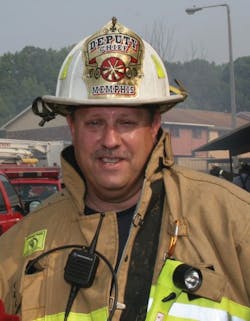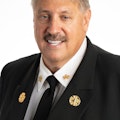It seems like no matter where I travel in the United States, it is common for people to say, “if you don’t like the weather in (insert whatever city you want), just wait a while. Unfortunately, the way things seem to be going lately, we’re going start saying, “when is the next active shooter incident going to happen – just wait a while.” They seem to almost come weekly now.
As I was writing this column, a gunman walked through a New Jersey shopping mall before apparently taking his own life. A few days earlier, an active shooter entered the Los Angeles airport, killing one Transportation Security Administration (TSA) agent and wounding several others. A week earlier, a Tennessee National Guardsman who had been fired walked in a recruiting station just outside Memphis and shot two other guardsmen. It seems to be happening almost every week. Chances are that by the time you are reading this column, there will be another active-shooter incident in the United States.
So chances are, eventually it may happen in your community since we are hearing it all too often now. If you look at the statistics from the FBI, active-shooter incidents have continued to increase in numbers each year since 2000.
Active shooter defined
The Department of Homeland Security (DHS) defines an active shooter as “an individual actively engaged in killing or attempting to kill people in a con?ned and populated area; in most cases, active shooters use ?rearm(s) and there is no pattern or method to their selection of victims.” Most of them fall into one of three categories; school shooters; rampage shooters who pick places at random to commit their crime; and active shooters who shoot people at their workplace.
Many active-shooter incidents have occurred the past several decades. In 1966, a sniper climbed a 28-story tower in 1966 on the University of Texas campus in Austin, killing 16 people and wounding 33 others before he was killed by two police officers. More recent high-profile cases include the Century Theater shooting in Aurora, CO, in which 12 people were killed and more than 70 wounded; the Sandy Hook school shooting in Newtown, CT, in which 20 children and six adults were killed; the Virginia Tech shooting in 2007 in which 32 people died and 25 were wounded; the Tucson, AZ, incident in 20111, in which six people were killed and 18 were wounded, including U.S. Rep. Gabrielle Giffords; the Navy Yard shooting in Washington, DC, where 12 people died and three were wounded; and the Fort Hood shooting in Texas in 2009 in which 13 people were killed and more than 30 were injured.
Unfortunately, what really put active-shooter incidents on the map and increased awareness was the Columbine High School shooting in 1999 in Littleton, CO. In that incident, two high school students killed 12 students and a teacher and wounded 23 others before they committed suicide. The students had planned the massacre for a while and even set off a diversionary propane bomb before their assault some distance away to send police and fire to another area, creating a delayed response. Although some of their plan fell apart when propane bombs failed to detonate in the cafeteria, they were allowed to kill because the police traditionally staged outside until specialized units could assault the building.
Now, law enforcement has a different approach to active shooters. Their goal is to enter the building as soon as possible and perform what they call the “three Fs”: find the suspects; fix them to a specific location; and finish them off by whatever means possible, including shooting them if necessary. Reviews of active-shooter cases reveal that many shooters will continue to fire and kill until confronted. Thus, the goal of law enforcement is to engage the assailant as soon as possible. Forty percent of active shooters kill themselves when confronted by law enforcement.
Fire and EMS tactics are changing also. Fire and EMS would traditionally stage some distance away and wait until the scene has been secured by law enforcement. Now, in many communities, police, fire and EMS are training together for active shooters.
Now, EMS and fire responders follow law enforcement into the “warm” and “hot” zones shortly after police enter the building to accomplish the “three Fs” with the shooter. New tactics, in conjunction with law enforcement, fire and EMS, call for establishing a casualty-collection point that is secured and held with police. All casualties are brought to this area, but are first searched for weapons. Fire and EMS agencies are varying their tactics, but the majority of strategies seem to have the police moving the casualties back to the collection point.
Studies from Iraq and Afghanistan have shown that once shooting victims receive treatment, they have a 90% chance of survival. Therefore, under these new tactics, the goal for fire and EMS is to get treatment to shooting victims as soon as possible.
Additional information dealing with active-shooter situations is available from a report issued in September 2013 by the U.S. Fire Administration (USFA) titled Fire/EMS Department Operational Considerations and Guide for Active-Shooter and Mass-Casualty Incidents. To view or download the report, go to http://www.usfa.fema.gov/fireservice/ops_tactics/disasters/.
For more news and training on EMS, visit http://EMSWorld.com/.
GARY LUDWIG, a Firehouse® contributing editor, has 35 years of fire, rescue and EMS experience. He currently serves as a deputy fire chief for the Memphis, TN, Fire Department. Ludwig is also chair of the EMS Section for the International Association of Fire Chiefs. He can be reached through his website at garyludwig.com.
About the Author
Gary Ludwig
GARY LUDWIG has served in three fire departments over his career: St. Louis, Memphis, and Champaign, IL. His fire, EMS and rescue career spanned a total of 46 years, and he has been a paramedic for over 44 years. Ludwig served as president of the International Association of Fire Chiefs in 2019-20. He has a Master’s degree in Business and Management, has written over 500 articles for professional fire and EMS publications and is the author of seven books.
Connect with Gary
Email: [email protected]
Facebook: Gary Ludwig
Twitter: @ChiefGaryLudwig
Website: garyludwig.com

